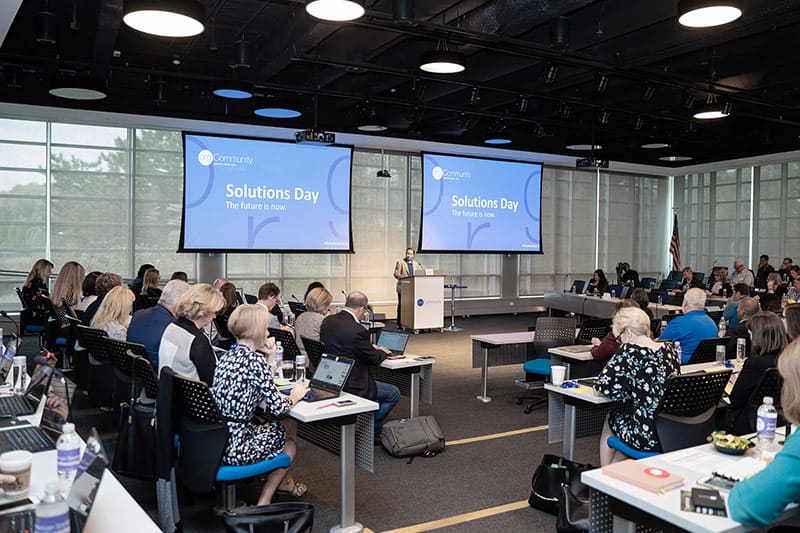Are you “leading” online learning?
Is your online learning and education business static, reactive, proactive or innovative?
How would you categorize your organization’s level of leadership, strategy, capacity, analytics and marketing as it pertains to online education and learning?
These are among the questions explored during the latest eLearning Thought Leaders Webinar, “The Learning Business Maturity Model,” held on April 25. The eLearning Thought Leaders webinar series is a collaborative effort of Web Courseworks and .orgCommunity.
Jeff Cobb and Celisa Steele, co-founders of Tagoras and experts in continuing education and professional development, discussed what comprises a “learning business,” the four stages of learning business maturity, and steps to take toward growing and developing elearning.
What is a ‘Learning Business?’
A learning business is one that fundamentally exists to generate revenue through selling learning and education products and services. The organization believes that lifelong learning is the imperative of our age, and that those who lead learning in their fields will lead their fields. The organization understands that learners don’t value expertise—they value outcomes, or practical opportunities they can apply to their daily lives. Learning businesses have established frameworks to surface and assess strategic and operational gaps, and a mechanism to move toward innovation—creating greater value and impact to their market segments.
Assessing Your Learning Business
Cobb and Steele believe organizations should view their learning and education business status by exploring five critical domains:
1. Leadership. How clear is the vision for the learning and education business? Is there a culture of learning throughout the organization and its audience?
2. Strategy. How clearly is the learning business strategy articulated? Is it shared and embraced broadly throughout the organization? Are there clear metrics that are tracked and is strategy adjusted based on analytics?
3. Capacity. Does the organization have sufficient capacity, in terms of human resources and technology, to pursue the vision and strategy effectively?
4. Portfolio. Are the content, methodologies, and modalities aligned with well-researched, thoroughly understood learner needs? Is the impact of learning assessed at multiple levels over time?
5. Marketing. Is there a validated understanding of the overall market and competitive environment? Are appropriate marketing methodologies used consistently and tracked for effectiveness?
These five critical domains can bring to light the learning business “stage” in which your organization is currently operating:
- Stage 1: Static—At this stage, organizations are focused on maintaining status quo with their learning business. There are limited attempts to adapt to changing needs. Decisions are reactional. There is a leadership vacuum. Strategy is poorly articulated. Capacity and processes are lacking. The approach to offerings is, “We’ve always done it that way.” There also is no validated understanding of the market—no nuanced or targeted marketing.
- Stage 2: Reactive—Organizations tend to respond to vocal minorities. They are largely transactional vs. focused on cultivating deep relationships. Education is led by a “lone wolf.” There are adequate resources for maintaining the status quo, but are insufficient for growth. There is a mixed portfolio of informational and performance-focused education offerings. An anecdotal understanding of the market exists, through ad hoc discussions with colleagues or the board. There is significant room for improvement.
- Stage 3: Proactive—Here, organizations responds to the learning market in a more informed and thoughtful manner, and attempts are made to uncover needs not readily apparent. A shared vision exists. Success metrics are tracked and responded to with some consistency. There are adequate resources for current and emerging needs. Multiple marketing channels are used.
- Stage 4: Innovative—A learning business may be considered mature at this stage. These organizations are uncovering new education needs. They are “leading” learning. A clear, compelling, broadly known vision exists. The learning strategy is embraced throughout the organization and tracked. There are adequate resources for growth and innovation. A validated understanding of the market exists and priorities for market segments are made.
Growth and Improvement
To grow and improve the learning business, Cobb and Steele recommend organizations survey a diverse group of stakeholders regarding its learning business maturity stage. Have the individuals complete the assessment individually, then average variances to determine the overall maturity of your learning and education business, and maturity level in the five specific domains. Then, hold a group discussion to talk about results and effect change. Read more about Tagoras’ Learning Business Maturity Model at http://www.tagoras.com/maturity.
The next eLearning Thought Leaders Webinar takes place on May 30, “Using Video to Drive Revenue for Learning Programs and Events,” led by Paul Gannon. You will learn how to target customers in different marketing and sales stages using video, and gain production tips to help you improve the performance of your videos. Register here!


